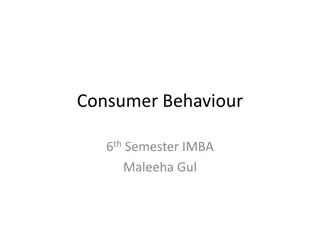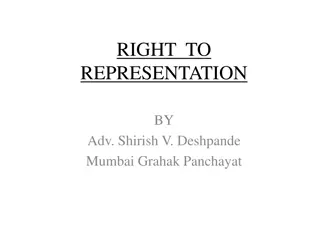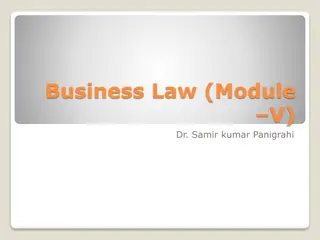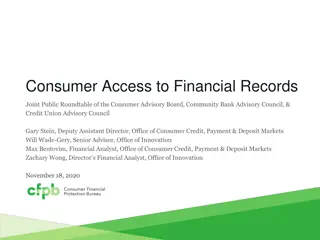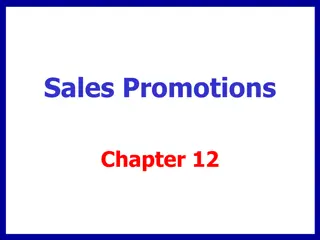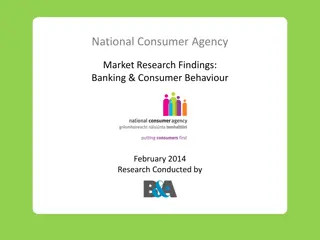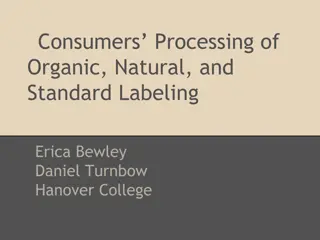Understanding Consumer Behavior: Key Factors and Influencing Factors
Explore the intricacies of consumer behavior through an in-depth analysis of key factors such as motivation, perception, learning, beliefs, and attitudes. Delve into psychological aspects like Maslow's Hierarchy of Needs, perception processes, learning mechanisms, and the impact of beliefs and attitudes on purchasing decisions. Discover how different types of buying behavior and roles influence consumer choices.
Download Presentation

Please find below an Image/Link to download the presentation.
The content on the website is provided AS IS for your information and personal use only. It may not be sold, licensed, or shared on other websites without obtaining consent from the author. Download presentation by click this link. If you encounter any issues during the download, it is possible that the publisher has removed the file from their server.
E N D
Presentation Transcript
Characteristics Affecting Consumer Behavior Motivation Perception Learning Beliefs and attitudes Key Factors Key Factors Cultural Social Personal Psychological 2
Psychological Factors Motivation A motive is a need that is sufficiently pressing to direct the person to seek satisfaction Motivation research is based on Freud. Looks for hidden and subconscious motivation Maslow ordered needs based on how pressing they are to the consumer 3
Psychological Factors Perception Perception is the process by which people select, organize, and interpret information. Perception Includes: Selective attention Consumers screen out information Selective distortion People interpret to support beliefs Selective retention People retain points to support attitudes 5
Psychological Factors Learning Learning describes changes in an individual s behavior arising from experience Learning occurs through Drives Internal stimulus that calls for action Stimuli Objects that move drive to motive Cues Minor stimuli that affect response Reinforcement Feedback on action 6
Psychological Factors Beliefs and Attitudes Belief a descriptive thought about a brand or service may be based on real knowledge, opinion, or faith Attitude describes a person s evaluations, feelings and tendencies toward an object or idea They are difficult to change 7
Types of Buying Decision Behavior
The Buying Roles 5 roles people might play in a buying decision Initiator who first gives the idea of buying the product or service Influencer whose view or advice influences the decision Decider who decide on any component of buying decision Buyer who makes the actual purchase User who uses the product or sevice purchased 9
Decision Making Sets Total Set Aware- ness Set Consid- eration Set Choice Set Decision 11
Stages in the Adoption Process Awareness: Consumer is aware of product, but lacks information. Interest: Consumer seeks Information about new product. Evaluation: Consumer considers trying new product. Trial: Consumer tries new product on a small scale. Adoption: Consumer decides to make regular use of product. 12
Buyer Decision Process for New Products Individual Differences in Innovativeness: Consumers can be classified into five adopter categories, each of which behaves differently toward new products 13
Adopter Categories Percentage of Adopters Early Majority Late Majority Innovators Early Adopters Laggards 34% 34% 16% 13.5% 2.5% Time of Adoption Late Early 14
Buyer Decision Process for New Products Product Characteristics influencing the adoption rate: Relative Advantage Is the innovation superior to existing products? Compatibility Does the innovation fit the values and experience of the target market? Complexity Is the innovation difficult to understand or use? Divisibility Can the innovation be used on a trial basis? Communicability Can results be easily observed or described to others? 15
Customer-Driven Marketing Strategy: Creating Value for Target Customers Lecture 11
Topics to be discussed 1. Market Segmentation 2. Market Targeting 3. Differentiation and Positioning
Market Segmentation Dividing a market into smaller groups with distinct needs, characteristics, or behavior that might require separate marketing strategies or mixes
Market Targeting The process of evaluating each market segment s attractiveness and selecting one or more segments to enter.
Differentiation Actually differentiating the market offering to create superior customer value.
Positioning Arranging for a market offering to occupy a clear, distinctive, and desirable place relative to competing products in the minds of target consumers.
Designing a Customer-Driven Marketing Strategy Select customers to serve Decide on a value proposition Differentiation Differentiate the market offering to create superior customer value. Segmentation Divide the total market into smaller segments. Create value for targeted customers Positioning Position the market offering in minds of target customers. Targeting Select the segment or segments to enter.
Market Segmentation Geographic segmentation Dividing a market into different geographical units such as nations, provinces, regions, parishes, cities, or neighborhoods. Examples World region or country: Western Europe, Middle East, Pacific Rim, China, India, Canada, Mexico, North America Country region: East Asia, South Asia, North Asia Density: Urban, suburban, exurban, rural
Market Segmentation Demographic segmentation Dividing the market into groups based on variables such as age, gender, family size, family life cycle, income, occupation, education, religion, race, generation, and nationality. Examples Age: Under 6, 6-11, 12-19, 20-34, 35-49, 50-64, 65+ Gender: Male, female Family life cycle: Young, single; married, no children; married with children; single parents, Income: Under $20,000; $20,000-$30,000; $30,000- $50,000; $50,000-$100,000; $100,000-$250,000; $250,000 and over
Market Segmentation Psychographic segmentation Dividing a market into different groups based on social class, lifestyle, or personality characteristics. Examples Social class: Lower lowers, upper lowers, working class, middle class, upper middles, lower uppers, upper uppers Lifestyle: Achievers, strivers, survivors Personality: Compulsive, gregarious, authoritarian, ambitious
Market Segmentation Behavioral segmentation Dividing a market into groups based on consumer knowledge, attitudes, uses, or responses to a product. Examples Occasions: Regular occasion; special occasion; holidays; seasonal Benefits: Quality, service, economy, convenience, speed User status: Nonuser, ex-user, potential user, first-time user, regular user User rates: Light user, medium user, heavy user
Can we use multiple segmentation bases? Yes. It can help companies to identify and better understand key customer segments, target them more efficiently, and tailor market offerings and messages to their specific needs.
Requirements for Effective Segmentation Measurable: not too hard to identify and measure Accessible: effectively reached and served Substantial: large or profitable enough to serve Differentiable: worthy to separate segments Actionable: possible to develop separate marketing programs






